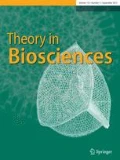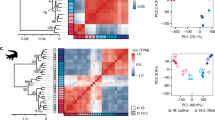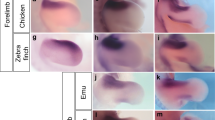Abstract
The identity of avian digits has been unresolved since the beginning of evolutionary morphology in the mid-19th century, i.e. as soon as questions of phylogenetic homology have been raised. The main source of concern is the persistent discrepancy between anatomical/paleontological and embryological evidence over the identity of avian digits. In this paper, recent evidence pertaining to the question of avian digit homology is reviewed and the various ideas of how to resolve the disagreement among developmental and phylogenetic evidence are evaluated. Paleontological evidence unequivocally supports the hypothesis that the fully formed digits of maniraptoran theropods are digits DI, DII, and DIII, because the phylogenetic position ofHerrerasaurus is resolved, even when hand characters are excluded from the analysis. Regarding the developmental origin of the three digits of the avian hand the discovery of an anterior digit condensation in the limb bud of chickens and ostriches conclusively shows that these three digits are developing from condensations CII, CIII, and CIV. The existence of this additional anterior condensation has been confirmed in four different labs, using four different methods: Alcian blue staining, PNA affinity histochemistry, micro-capillary regression andSox9 expression. Finally, recent evidence shows that the digit developing from condensation CII has a Hox gene expression pattern that is found in digit DI of mice forelimb and chick hind limbs. The sum of these data supports the idea that digit identity has shifted relative to the location of condensations, known as Frame Shift Hypothesis, such that condensation CII develops into digit DI and condensation CIII develops into digit DII, etc. A review of the literature on the digit identity of the Italian Three-toed Skink orLuscengola (Chalcides chalcides), shows that digit identity frame shifts may not be limited to the bird hand but may be characteristic of “adaptive” digit reduction in amniotes (sensu Steiner, H., Anders, G., 1946. Zur Frage der Entstehung von Rudimenten. Die Reduktion der Gliedmassen vonChalcides tridactylus Laur. Rev. Suisse Zool. 53, 537–546) in general. In this mode of evolution two digits are lost, in the course of the adaptation of the three anterior digits to a function that does not require the two posterior digits. This evidence suggests that the evolution of digits in tetrapods can proceed at least on two distinct levels of integration, the level of digit condensations and that of adult digits.
Similar content being viewed by others
References
Amundson, R., 2005. The Changing Role of the Embryo in Evolutionary Thought: Roots of Evo-Devo. Cambridge University Press, Cambridge.
Benedetto, J.L., 1973. Herrerasauridae, nueva familia de sarisquios triscos. Ameghiniana 10, 89–102.
Brandley, M.C., Schmitz, A., et al., 2005. Partitioned Bayesian analysies, partion choice and the phylogenetic relationships of Scincid lizards. Syst. Biol. 54, 373–390.
Braus, H., 1906. Die Entwicklung der Form der Extremitäten und des Extremitätenskeletts. Handbuch der vergleichenden und experimentellen Entwicklungslehre der Wirbeltiere. O. Hertwig. Jena, Gustav Fisher 3 (part 2), 167–338.
Bruno, S., Maugeri, S., 1976. Rettili d’Italia: Tartarughe e Sauri. I.A. Martello, Firenze, Italia.
Burke, A.C., Alberch, P., 1985. The development and homology of the chelonian carpus and tarsus. J. Morph. 186, 119–131.
Burke, A.C., Feduccia, A., 1997. Developmental patterns and the identification of homologies in the avian hand. Science 278, 666–668.
Caputo, V., Lanza, B., et al., 1995. Body elongation and limb reduction in the genusChalcides Laurenti 1768 (Squamata Scincidae): a comparative study. Trop. Zool. 8, 95–152.
Carroll, S.B., Grenier, J.K., et al., 2001. From DNA to Diversity, Blackwell Science, Malden, MA.
Chatterjee, S., 1998. Counting the fingers of birds and dinosaurs. Science 280, 355a.
Colbert, E., 1970. A saurischian dinosaur from the Triassic of Brazil. Am. Mus. Novitates 2405, 1–39.
Dahn, R.D., Fallon, J.F., 2000. Interdigital regulation of digit identity and homeotic transformation by modulated BMP signaling. Science 289, 438–441.
Dunlop, L.-L.T., Hall, B.K., 1995. Relationships between cellular condensation, preosteoblast formation and epithelial-mesenchymal interactions in initiation of osteogenesis. Int. J. Dev. Biol. 39, 357–371.
Fabrezi, M., 2001. A survey of prepollex and prehallux variation in anuran limbs. Zool. J. Linn. Soc. 131, 227–248.
Feduccia, A., Nowicki, J., 2002. The hand of birds revealed by early ostrich embryos. Naturwissenschaften 89, 391–393.
Feduccia, A., 1996. The Origin and Evolution of Birds. Yale University Press, New Haven.
Feduccia, A., 1999, 1,2,3=2,3,4: accommodating the cladogram. Proc. Natl. Acad. Sci. USA 96, 4740–4742.
Feduccia, A., 2001. Digit homology of birds and dinosaurs: accommodating the cladogram. TrEE 16, 285–286.
Feduccia, A., Nowicki, J., 2002. The hand of birds revealed by early ostrich embryos. Naturwissenschaften 89, 391–393.
Fürbringer, M., 1870. Die Knochen und Muskeln der Extremitäten bei den schlangenähnlichen Sauriern: Vergleichend Anatomische Abhandlung. Verlag von Wilhelm Engelmann, Leipzig.
Galis, F., Kundrát, M., et al., 2005. Hox genes, digit identities and the theropod/bird transition. J. Exp. Zool. Part B (Mol. Dev. Evol.), 304B, 198–205.
Galis, F., Kundrát, M., et al., 2003. An old controversy solved: bird embryos have five fingers. TrEE 18, 7–9.
Garner, J.P., Thomas, A.L.R., 1998. Counting the fingers of birds. Science 280, 355.
Gauthier, J., 1986. Saurischian monophyly and the origin of birds. Mem. Calif. Acad. Sci. 8, 1–55.
Grandel, H., Schulte-Merker, S., 1998. The development of the paired fins the Zebrafish (Danio rerio). Mech. Dev. 79, 99–120.
Greer, A.E., 1991. Limb reduction in Squamates: identification of the lineages and discussion of the trends. J. Herpetol. 25, 166–173.
Greer, A.E., Caputo, V., et al., 1998. Observations on limb reduction in the Scincid lizard genusChalcides. J. Herpetol. 32, 244–252.
Hall, B.K., 1994. Homology and embryonic development. In: Hecht, M.K., MacIntyre, R.J., Clegg, M.T. (Eds.), Evolutionary Biology, vol. 28. Plenmum Press, New York, pp. 1–30.
Hall, B.K., 1998. Evolutionary Developmental Biology. Chapman & Hall, London.
Hall, B.K., Miyake, T., 1995. Divide, accumulate, differentiate: cell condensation in skeletal development revisited. Int. J. Dev. Biol. 39, 881–893.
Heiss, H., 1957. Beiderseitige kongenitale daumenlose Fünffingerhand bei Mutter und Kind. Z. Anat. Entwicklungsgesch. 120, 226–231.
Hinchliffe, J., 1977. The chondrogenic pattern in chick limb morphogenesis: a problem of development and evolution. In: Ede, D.A., Hinchliffe, J.R., Balls, M. (Eds.), Vertebrate Limb and Somite Morphogenesis. Cambridge University Press, Cambridge, UK, pp. 293–309.
Hinchliffe, J.R., Griffiths, P.J., 1983. The prechondrogenic patterns in tetrapod limb development and their phylogenetic significance. In: Goodwin, B.C., Holder, N., Wylie, C.C. (Eds.), Development and Evolution. Cambridge University Press, Cambridge, pp. 99–121.
Hinchliffe, J.R., Hecht, M., 1984. Homology of the bird wing skeleton. Evol. Biol. 20, 21–37.
Hinchliffe, J.R., Johnson, D.R., 1980. The Development of the Vertebrate Limb. Oxford University Press, New York.
Hiraki, Y., Shukunami, C., 2000. Chondromodulin-I as a novel cartilcage-specific growth-modulating factor. Pediatr. Nephrol. 14, 602–605.
Holtz Jr., T.R., 1995. A new phylogeny of the Theropoda. J. Vert. Paleont. 15, 35A.
Joachimsthal, G., 1900. Verdoppelung des linken Zeigefingers und Dreigliederung des rechten Daumens. Berl. Klin. Wochenschr. 37, 835–838.
Kundrát, M., Seichert, V., et al., 2001. Developmental remnants of the first avian metacarpus. J. Morphol. 248, 252A.
Kundrát, M., Seichert, V., et al., 2002. Pentadactyl pattern of the avian wing autopodium and pyramid reduction hypothesis. J. Exp. Zool. (Mol. Dev. Evol.) 294, 152–159.
Larsson, H.C.E., Wagner, G.P., 2002. The pentadactyl ground state of the avian wing. J. Exp. Zool. (Mol. Dev. Evol.) 294, 146–151.
Litingtung, Y., Dahn, R.D., et al., 2002. Shh and Gli3 are dispensable for limb skeleton formation but regulate digit number and identity. Nature 418, 979–983.
Montagna, W., 1945. A re-investigation of the development of the wing of the bird. J. Morphol. 76, 87–118.
Müller, G.B., Alberch, P., 1990. Ontogeny of the limb skeleton inAlligator mississippiensis: Developmental invariance and change in the evolution of Archosaur limbs. J. Morphol. 203, 151–164.
Novas, F.E., 1993. New Information on the systematics and postcranial skeleton ofHerrerasaurus ischigualastensis (Theropoda: Herrerasauridae) from the Ischigualasto formation (Upper Triassic) of Argenita. J. Vert. Paleont. 13, 400–423.
Novas, F.E., 1997. Herrerasauridae. In: Currie, P.J. Padian, K. (Eds.), Encyclopedia of Dinosaurs. Academic Press, San Diego.
Nyhart, L.K., 1995. Bioloy Takes Form. Animal Morphology and the German Universities, 1800–1900. University of Chicago Press, Chicago, IL.
Nyhart, L.K., 2002. Learning from history: morphology’s challenges in Germany ca. 1900. J. Morphol. 252, 2–14.
Orsini, J.-P., Cheylan, M., 1981.Chalcides chalcides (Linnaeus 1758)—Erzschleiche. In: Böhme, W. (Ed.), Handbuch der Reptilien und Amphibien Europas, vol. 1. Akademische Verlagsgesellschaft, Wiesbaden, pp. 318–337.
Padian, K., 1992. A proposal to standartize tetrapod phalangeal formula designations. J. Vert. Paleontol. 12, 260–262.
Padian, K., May, C.L., 1993. The earliest dinosaurs. New Mexico Museum of Natural History & Science Bull 3, 379–381.
Prum, R.O., 2002. Why ornithologists should care about the theropod origin of birds. Auk 119, 1–17.
Qazi, Q., Kassner, E.G., 1988. Triphalangeal thumb. J. Med. Genet. 25, 505–520.
Raff, R., 1996. The Shape of Life. Chicago University Press, Chicago, IL.
Raynaud, A., Clergue-Gazeau, M., 1986. Identification des doigts reduits ou manquanta dans les pattes des embryons de lezard vert (Lacerta viridis) tarites par la cytosine-arabinofuranoside. Camparaison avec les derductions digitales naturalles des speces de reptiles sependtiformes. Arch. Biol. (Bruxelles) 97, 279–299.
Raynaud, A., Clergue-Gazeau, M., et al., 1986. Remarques preliminaires sur la structure de la patte du Seps tridactyle (Chalcides chalcides, L.). Bull. Soc. Hist. Nat., Toulouse 122, 109–111.
Reig, O.A., 1963. La presencia de dinosaurios saurisquios en los “Estratos de Ischigualasto” (Mesotriasico superior) de las procvincias de San Juan y La Rioja (Republica Argentina). Ameghiniana 3, 3–20.
Renous-Lecuru, S., 1973. Morphologie comparee du carpe chez les Lepidosauriens actuels (Rhynchocephales, Lacertilens, Amphisbeniens). Gegenbaurs Morphol. Jahrb., Leipzig 119, 727–766.
Riddle, R.D., Johnson, R.L., et al., 1993. Sonic hedgehog mediates the polarizing activity of the ZPA. Cell 75, 1401–1416.
Schwarzbach, M., 1980. Alfred Wegener und die Drift der Kontinente. Wissenschaftliche Verlagsgesellschaft, Stuttgart.
Seichert, V., Rychter, Z., 1972. Vascularization of developing anterior limb of the chick embryo II. Differentiation of vascular bed and its significance for the location of morphogenetic processes inside the limb bud. Folia Morphol. (Warsz.) 19, 352–361.
Sereno, P.C., 1993. Dinosaurian percursors from the Middle Triassic of Argentina:Lagerpeton chanarensis. J. Vert. Paleo. 13, 385–399.
Sereno, P., 1994. The pectoral girdle and forelimb of the basal theropodHerrerasaurus ischigualestensis. J. Vert. Paleont. 13 (4), 425–450.
Sereno, P.C., 1999a. The evolution of dinosaurs. Science 284, 2137–2147.
Sereno, P.C., 1999b. A rationale for dinosaurian taxonomy. J. Vert. Paleont. 19, 788–790.
Sereno, P.C., Novas, F.E., 1992. The complete skull and skeleton of an early dinosaur. Science 258, 1137–1140.
Sereno, P.C., Foster, C.A., et al., 1993. Primitive dinosaur skeleton from Argentina and the early evolution of Dinosauria. Nature 361, 64–66.
Sewertzoff, A.N., 1931. Studien über die Reduktion der Organe der Wirbeltiere. Zool. Jahrbuch; Abt.f. Anatomie, Jena 53, 611–699.
Shubin, N.H., 1994. The phylogeny of development and the origin of homology. In: Grande, L., Rieppel, O. (Eds.), Interpreting the Hierarchy of Nature. Academic Press, San Diego.
Shubin, N.H., Alberch, P., 1986. A morphogenetic approach to the origin and basic organization of the tetrapod limb. Evol. Biol. 20, 319–387.
Steiner, H., 1934. Über die embryonale Hand- und Fuss-Skelettanlage bei den Crocodiliern, sowie über ihre Beziehung zur Vogel-Flügelanlage und zur ursprünglichen Tetrapoden-Extremität. Rev. Suisse Zool. 41, 383–396.
Steiner, H., Anders, G., 1946. Zur Frage der Entstehung von Rudimenten. Die Reduktion der Gliedmassen vonChalcides tridactylus Laur. Rev. Suisse Zool. 53, 537–546.
Swanson, A.B., Brown, K.S., 1962. Hereditary triphalangeal thumb. J. Heredity 53, 259–265.
Vargas, A., Fallon, J.F., 2005. Birds have dinosaur wings: the molecular evidence. J. Exp. Zool. Part B (Mol. Dev. Evol.) 304B, 86–90.
Wagner, G.P., Gauthier, J.A., 1999. 1,2,3=2,3,4: A solution to the problem of the homology of the digits in the avian hand. PNAS 96, 5111–5116.
Wagner, G.P., Misof, B.Y., 1993. How can a character be developmentally constrained despite variation in developmental pathways? J. Evol. Biol. 6, 449–455.
Warm, A., Pietro, C.d., et al., 1988. Non-opposable triphalangeal thumb in an Italian family. J. Med. Genet. 25, 337–339.
Weiss, K.M., Fullterton, S.M., 2000. Phenotypic drift and the evolution of genotype-phenotype relationships. Theor. Pop. Biol. 57, 187–195.
Welscher, P.t., Zuniga, A., et al., 2002. Progression of vertebrate limb development through Shh-mediated counteraction of GLI3. Science 298, 287–830.
Welten, M.C.M., Verbeek, F.J., et al., 2005. Gene expression and digit homology in the chicken embryo wing. Evol. Dev. 7, 18–28.
Zschabitz, A., 1998. Glycoconjugate expression and cartilage development of the cranial skeleton. Acta Anat. 61, 254–274.
Author information
Authors and Affiliations
Corresponding author
Additional information
From the 46th “Phylogenetisches Symposium”, Jena, Germany, November 20–21, 2004. Theme of the symposium: “Evolutionary developmental biology—new challenges to the homology concept?”
Rights and permissions
About this article
Cite this article
Wagner, G.P. The developmental evolution of avian digit homology: An update. Theory Biosci. 124, 165–183 (2005). https://doi.org/10.1007/BF02814482
Received:
Accepted:
Issue Date:
DOI: https://doi.org/10.1007/BF02814482




